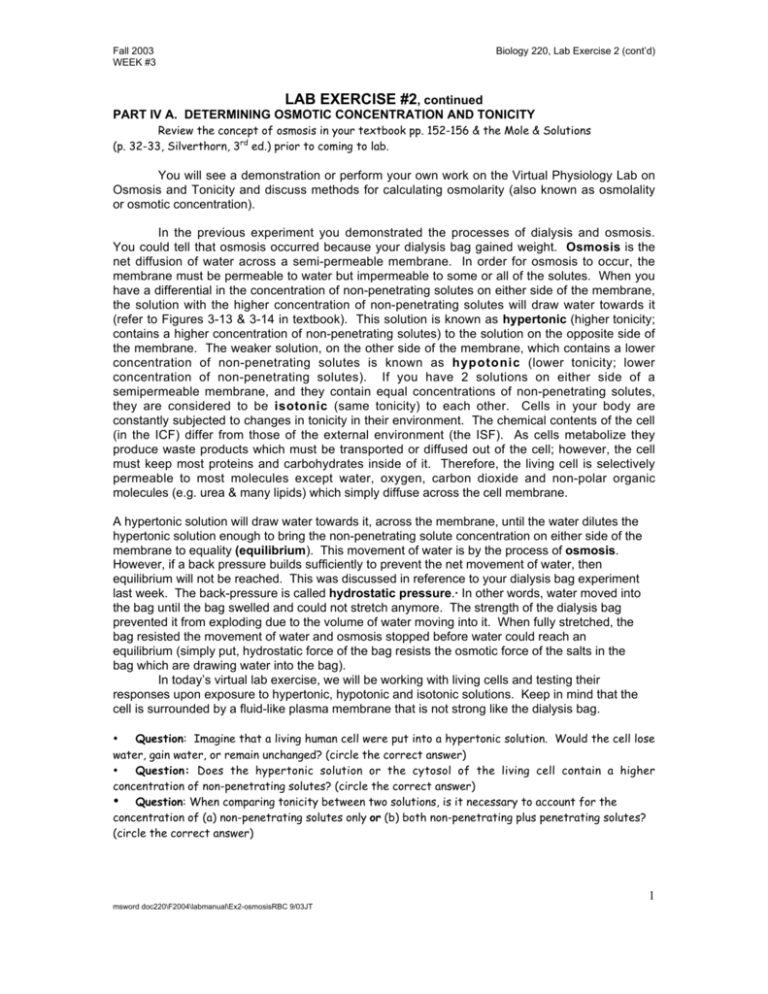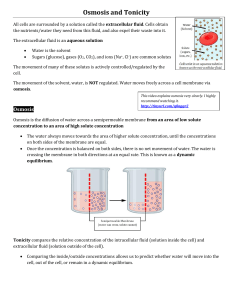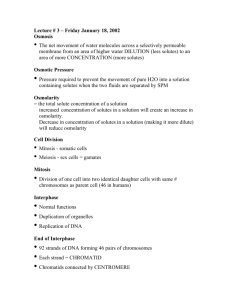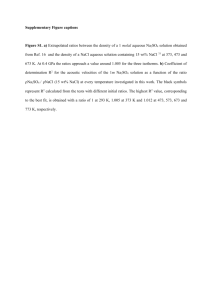LAB EXERCISE #2, continued
advertisement

Fall 2003 WEEK #3 Biology 220, Lab Exercise 2 (cont’d) LAB EXERCISE #2, continued PART IV A. DETERMINING OSMOTIC CONCENTRATION AND TONICITY Review the concept of osmosis in your textbook pp. 152-156 & the Mole & Solutions (p. 32-33, Silverthorn, 3rd ed.) prior to coming to lab. You will see a demonstration or perform your own work on the Virtual Physiology Lab on Osmosis and Tonicity and discuss methods for calculating osmolarity (also known as osmolality or osmotic concentration). In the previous experiment you demonstrated the processes of dialysis and osmosis. You could tell that osmosis occurred because your dialysis bag gained weight. Osmosis is the net diffusion of water across a semi-permeable membrane. In order for osmosis to occur, the membrane must be permeable to water but impermeable to some or all of the solutes. When you have a differential in the concentration of non-penetrating solutes on either side of the membrane, the solution with the higher concentration of non-penetrating solutes will draw water towards it (refer to Figures 3-13 & 3-14 in textbook). This solution is known as hypertonic (higher tonicity; contains a higher concentration of non-penetrating solutes) to the solution on the opposite side of the membrane. The weaker solution, on the other side of the membrane, which contains a lower concentration of non-penetrating solutes is known as hypotonic (lower tonicity; lower concentration of non-penetrating solutes). If you have 2 solutions on either side of a semipermeable membrane, and they contain equal concentrations of non-penetrating solutes, they are considered to be isotonic (same tonicity) to each other. Cells in your body are constantly subjected to changes in tonicity in their environment. The chemical contents of the cell (in the ICF) differ from those of the external environment (the ISF). As cells metabolize they produce waste products which must be transported or diffused out of the cell; however, the cell must keep most proteins and carbohydrates inside of it. Therefore, the living cell is selectively permeable to most molecules except water, oxygen, carbon dioxide and non-polar organic molecules (e.g. urea & many lipids) which simply diffuse across the cell membrane. A hypertonic solution will draw water towards it, across the membrane, until the water dilutes the hypertonic solution enough to bring the non-penetrating solute concentration on either side of the membrane to equality (equilibrium). This movement of water is by the process of osmosis. However, if a back pressure builds sufficiently to prevent the net movement of water, then equilibrium will not be reached. This was discussed in reference to your dialysis bag experiment last week. The back-pressure is called hydrostatic pressure.· In other words, water moved into the bag until the bag swelled and could not stretch anymore. The strength of the dialysis bag prevented it from exploding due to the volume of water moving into it. When fully stretched, the bag resisted the movement of water and osmosis stopped before water could reach an equilibrium (simply put, hydrostatic force of the bag resists the osmotic force of the salts in the bag which are drawing water into the bag). In today’s virtual lab exercise, we will be working with living cells and testing their responses upon exposure to hypertonic, hypotonic and isotonic solutions. Keep in mind that the cell is surrounded by a fluid-like plasma membrane that is not strong like the dialysis bag. • Question: Imagine that a living human cell were put into a hypertonic solution. Would the cell lose water, gain water, or remain unchanged? (circle the correct answer) • Question: Does the hypertonic solution or the cytosol of the living cell contain a higher concentration of non-penetrating solutes? (circle the correct answer) • Question: When comparing tonicity between two solutions, is it necessary to account for the concentration of (a) non-penetrating solutes only or (b) both non-penetrating plus penetrating solutes? (circle the correct answer) 1 msword doc220\F2004\labmanual\Ex2-osmosisRBC 9/03JT Fall 2003 WEEK #3 Biology 220, Lab Exercise 2 (cont’d) 1. Calculating Osmotic Concentration: Before proceeding with these calculations, read pp. 32-33 in your textbook by Silverthorn (3rd ed.). BACKGROUND: Any compound that dissolves in water and then dissociates (breaks apart) will produce an osmotic concentration which is greater than its MOLARITY (molarity was described by your instructor). Solutes that dissociate readily in water are usually held together ionically instead of covalently. Ionic bonds are weak compared to covalent bonds and ionic bonds break in the presence of polar water molecules. If a molecule dissociates into 2 ions when put in water, its osmotic concentration is twice that of its molar concentration. If another molecule dissociates into 3 ions in water, its osmotic concentration is 3 times that of its molar concentration. This is due to the fact that each individual ion contributes to the osmotic force of a solution. A molecule which does not dissociate in water will have an osmotic concentration equal to its molar concentration. Osmotic concentration is designated as osmolality. PERFORM THE FOLLOWING CALCULATIONS prior to coming to lab: Q1. If you dissolve 58 grams of sodium chloride (NaCl) in 1 liter of water, what is its molarity? + Q2. Assume that 1 molecule of NaCl dissociates completely into 1 sodium ion (Na ) and 1 chloride ion - (Cl ) in water. Explain how would you calculate the osmolality of a solution of NaCl. 2. Virtual Physiology Exercise - “ Osmosis” (An In-Class Exercise) Create a title for the table below and enter the data as presented to you during the Virtual Physiology Exercise, which will be available on the laboratory computer: Table 1. (title CONTENTS Tube no. 1 10g NaCl/dl 2 3.5g NaCl/dl 3 0.85g NaCl/dl 4 0.45g NaCl/dl 5 0.20g NaCl/dl APPEARANCE OF RBC DIAMETER OF RBC (um) Tonicity of solution (based on @appearance of RBC) MOLARITY * OF NaCl Osmolality# OF NaCl M OsM @Note: RBCs have an ICF concentration of 0.3 OsM non-penetrating solutes (e.g. NaCl) *SAMPLE CALCULATION for a 5 g NaCl/dl solution: (5g NaCl/dl) x (1 mole/58 g) x (10dl/1 liter)= 50 moles/ 58 liters = 0.86 moles / liter = 0.86 M # since NaCl dissociates into 2 ions in solution the osmolality is obtained by multiplying 0.86 x 2 = 1.72 Osm 2 msword doc220\F2004\labmanual\Ex2-osmosisRBC 9/03JT Fall 2003 WEEK #3 Biology 220, Lab Exercise 2 (cont’d) Answer the following questions, after calculating the Molarity & Osmolality in Table 1: • Based on the knowledge that the RBC cytosol and the blood plasma each have an osmolality of 300 milli-Osm, which of the solutions in Table 1 is closest to isotonic? ________________ • Which of the solutions in Table 1 are HYPERTONIC to the RBCs? __________________ • Which of the solutions in Table 1 are HYPOTONIC to the RBCs? ___________________ PART IV B: DEMONSTRATING THAT TWO SOLUTIONS OF DIFFERING OSMOLARITY CAN EXHIBIT THE SAME TONICITY. In contrast to tonicity, another set of terms - isoosmotic, hyperosmotic, and hypoosmotic - denotes simply the osmolarity of a solution relative to that of normal extracellular fluid without regard to whether the solute is penetrating or non-penetrating. TONICITY & OSMOLARITY mean different things. Review: Remember that terms associated with TONICITY may only be used when comparing the concentrations of non-penetrating solutes of two (2) solutions. OSMOLARITY denotes the additive concentration of all chemicals in a single solution (you need to know if any of the molecules placed into solution will dissociate and into how many pieces each molecule dissociates). MOLARITY denotes the concentration of a single chemical compound that was put into the solution, disregarding any dissociations that may have occurred after the solute was added to the water. For example, a 1 L solution containing 150 milli-molar (0.15 Molar) of nonpenetrating NaCl (MW = 58) has an osmolarity of 300 milli-osmolar (0.3 OsM) because the Na & Cl dissociate in water. Urea [chemical formula: CO (NH2)2 ; mol. wt.= 60], on the other hand, is a solute that will not dissociate when it is dissolved in water, but it can penetrate the plasma membrane of cells. If a 150mM (milli-molar = 0.1 M) solution of urea was made, it would still have an osmolarity of 150 mOsM (milli-osmolar). Attempt to answer the following questions before coming to lab: 1. Using the definitions above, which of the 2 solutions in the previous 2 paragraphs is hypertonic to the other (150 mM NaCl or 150 mM Urea)? WHY? 2. Now consider the following 2 solutions: a. 150 mM NaCl solution b. 150 mM NaCl + 150 mM urea solution Calculate the Osmolarity of solutions 2a & 2b. Write the answer next to each solution above. Which solution is hyperosmotic (contains a higher concentration of solute particles)?_________ Now assume that you have a cell that contains 150 mM NaCl in its cytosol. How would you describe the tonicity of solution #1 to the cytosol? How would you describe the tonicity of solution #2 to the cytosol? 3 msword doc220\F2004\labmanual\Ex2-osmosisRBC 9/03JT Fall 2003 WEEK #3 Biology 220, Lab Exercise 2 (cont’d) If you answered that solution #1 and solution #2 are both isotonic to the cytosol, you are right. Since urea is a penetrating solute, a cell placed into solution #2 would not visibly change, since the concentration of non-penetrating solutes are equal between the extracellular environment and the intracellular environment. The urea in solution #2 would simply diffuse into the cell and come to an equilibrium. No net osmosis would occur. So, we could hypothesize that if living cells are placed into a hyperosmotic solution which contains a concentration of non-penetrating solutes which are equal to the concentration of nonpenetrating solutes in the cell (an isotonic condition), there will be no change in the volume of the cell since there will be no net diffusion of water into or out of the cell. This is due to the fact that the ICF and ECF are isotonic. The solution into which the cells are placed is hyperosmotic but isotonic to the cytosol. 4 msword doc220\F2004\labmanual\Ex2-osmosisRBC 9/03JT Fall 2003 WEEK #3 Biology 220, Lab Exercise 2 (cont’d) HOMEWORK ASSIGNMENT: DUE AT THE BEGINNING OF THIS WEEK’S LAB . Fill in the table on this page and design an experiment as described below. NAME _______________________________________ DUE at beginning of lab (HOMEWORK ASSIGNMENT) Before answering the questions below, read pages 1-4 in this lab exercise (ex. #2, part IVa). In the table below, fill in the blank boxes, to indicate what the osmotic concentration and tonicity of each solution (left column) is in comparison to the cytosol of a living cell (300mOsM total solutes, all of which are non-penetrating): see example for first solution. Table 2. Osmotic concentration and Tonicity of solution relative to intracellular fluid ( cytosol) Calculate the total Osmotic Conc. of soln. Tonicity of Solution Compared A solution of osmotic Compared to cell ICF to the ICF of the Cell water, concentration of the (300mOsM) (300mOsM) containing: solution (OsM) e.g. 0.3 Osm e.g. iso-osmotic isotonic 300 mOsM NaCl 400 mOsM NaCl 300mOsM NaCl + 100 mOsM urea 400 mOsM urea In the space below, design a simple experiment that would demonstrate the following hypothesis: A solution that is hypertonic and hyperosmotic to living cells will cause living cells to shrink ; whereas a solution that is isotonic and hyperosmotic will not cause any visual changes in the cells. Include an appropriate negative control in your experimental design . HINTS: You will need to place living cell (circle below) into each of 3 different solutions (rectangle below) . Assume that the concentration of non-penetrating solutes inside the cell is 300mOsM. You should use NaCl and urea alone or in combination to run your test. You may want to choose any of the solutions from the table above. In each rectangle indicate what your solution is composed of and in the blank below each rectangle, indicate what the osmotic concentration and tonicity of the solution are in relation to the cell. Also indicate which sample would be your control (A, B or C). A B C 5 msword doc220\F2004\labmanual\Ex2-osmosisRBC 9/03JT





